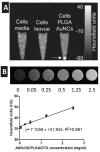PLGA-Gold Nanocomposite: Preparation and Biomedical Applications
- PMID: 35336033
- PMCID: PMC8949597
- DOI: 10.3390/pharmaceutics14030660
PLGA-Gold Nanocomposite: Preparation and Biomedical Applications
Abstract
A composite system consisting of both organic and inorganic nanoparticles is an approach to prepare a new material exhibiting "the best of both worlds". In this review, we highlight the recent advances in the preparation and applications of poly(lactic-co-glycolic acid)-gold nanoparticles (PLGA-GNP). With its current clinically use, PLGA-based nanocarriers have promising pharmaceutical applications and can "extract and utilize" the fascinating optical and photothermal properties of encapsulated GNP. The resulting "golden polymeric nanocarrier" can be tracked, analyzed, and visualized using the encapsulated gold nanoprobes which facilitate a better understanding of the hosting nanocarrier's pharmacokinetics and biological fate. In addition, the "golden polymeric nanocarrier" can reveal superior nanotherapeutics that combine both the photothermal effect of the encapsulated gold nanoparticles and co-loaded chemotherapeutics. To help stimulate more research on the development of nanomaterials with hybrid and exceptional properties, functionalities, and applications, this review provides recent examples with a focus on the available chemistries and the rationale behind encapsulating GNP into PLGA nanocarriers that has the potential to be translated into innovative, clinically applicable nanomedicine.
Keywords: PLGA; composite; gold nanoparticles; poly(lactic-co-glycolic acid).
Conflict of interest statement
The authors declare that they have no conflict of interest.
Figures








References
Publication types
LinkOut - more resources
Full Text Sources
Other Literature Sources

